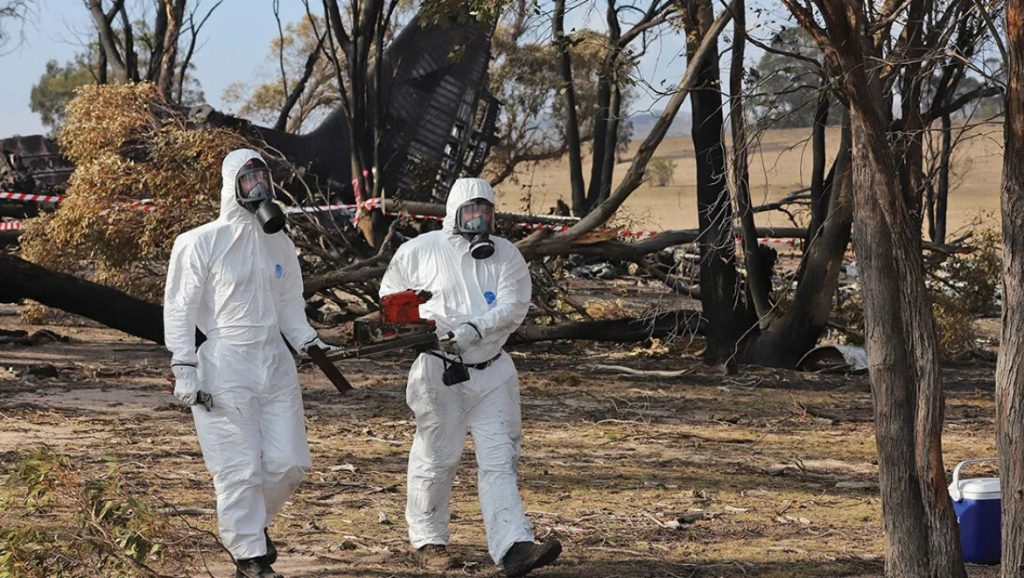
The families of two of the American firefighters who died tackling a Black Summer blaze are set to take the NSW Rural Fire Service and Coulson Aviation to court.
Captain Ian McBeth’s widow Bowdoin McBeth told The Australian, “Those in the best position to determine if it was safe to send the plane up have let all of our families down, and they have a lot to answer for.”
On Monday, an ATSB report found wind shear caused the pilots’ Lockheed C-130 to stall, leading it to hit the ground in the NSW Snowy Mountains. First officer Paul Hudson and flight engineer Rick DeMorgan also died.
However, the bureau concluded Coulson Aviation did not include a wind shear recovery procedure in its C-130 flight manual, and the aircraft was not fitted with a wind shear detection system. It also concluded the RFS had “no procedures” for the deployment of firefighting aircraft without aerial supervision.
Mrs McBeth said she hoped changes implemented as a result of the investigation would mean “no other families have to endure what I have been through and will continue to suffer for the remainder of our lives”.
Shine Lawyers told the newspaper it was acting for both Mrs McBeth and her family, alongside the widow of the first office Paul Hudson.
Earlier this week, Coulson told Australian Aviation it worked “hand in hand” with the ATSB to provide the information it needed, and said the organisation’s loss of the three firefighters was still “deeply felt”.
“Our aircraft and teams operate more than 8,000 firefighting missions worldwide each year, with the largest wildfire agencies in the world,” said CEO Wayne Coulson.
“We operate under our industry-leading safety management system and operational procedures which assess and manage risks unique to the aerial firefighting environment.
“As the largest Australian supplier of large firefighting aircraft, we continue to innovate and improve our aircraft, policies, procedures, and practices to provide our customers with safe and effective aerial firefighting operations.
“We have full confidence in our aircraft and in our team members, and the safety of our team while conducting aerial firefighting operations across the world remains the number one focus of the organisation.”
The incident on 23 January 2020 was one of the most high-profile tragedies of Australia’s Black Summer bushfire season, while the C-130 is the largest non-military aircraft to have ever crashed in Australia.
The ATSB’s chief commissioner, Angus Mitchell, said, “The ATSB recognises the critical importance of aerial firefighting, where aircraft are flown at low altitudes and low airspeeds, often in challenging conditions, in the management and suppression of bushfires in Australia.”
Mitchell added Coulson subsequently took proactive safety actions in response to the accident, including the introduction of a pre-flight risk assessment tool, a new three-tiered risk management approach, and windshear procedures and training.
Separately, the ATSB said the NSW Rural Fire Service had no procedures for the deployment of firefighting aircraft without aerial supervision. It led to the RFS committing to undertake a comprehensive review of RFS aviation doctrine.
Mitchell said he welcomed that commitment but said the ATSB had nonetheless issued three safety recommendations to the RFS to take further action to reduce the risk associated with three safety issues identified in the investigation.
These concern managing and communicating task rejections, aerial supervision requirements, and initial attack certification.
The ATSB has also issued two safety recommendations to Coulson Aviation. These are to further consider the fitment of a windshear detection system to their C-130 aircraft, and to incorporate foreseeable external factors into their pre-flight assessment tool.
















Kon
says:With all sympathy to the bereived , ultimately the resposiblity for descisions on aircraft safety rests with the aircraft`s operating crew. Lawyers will allways see a government department as a fat target for compensation . Coulson should obviously and its procedures should obviously be held responsible.
Graham Haxell
says:What do the families of the deceased hope to achieve by suing either party? Is this the American way, to sue for all you can get?
Kon
says:“more than 8,000 firefighting missions worldwide each year, with the largest wildfire agencies in the world,” said CEO Wayne Coulson.”
With this level of expertise Coulson and its captains would be the foremost authority on the safety of operating in aviation adverse conditions, not their RFS clients..